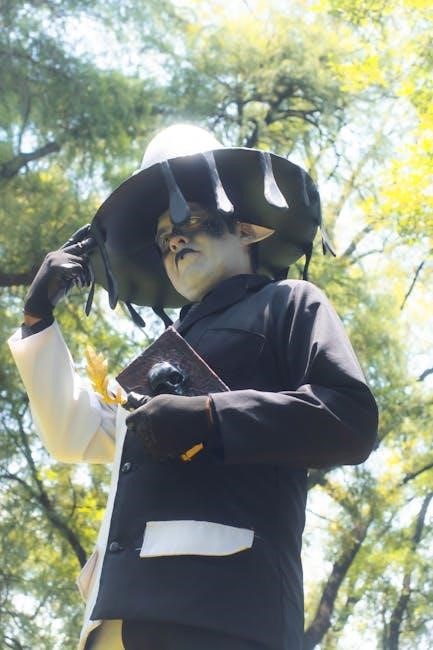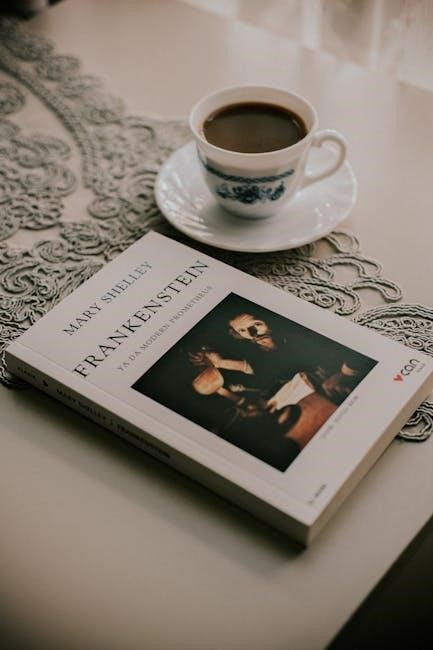Book 9 of the Odyssey recounts Odysseus’s encounter with the Cyclops Polyphemus, showcasing his cunning and bravery․ This episode is central to the epic, exploring themes of hospitality, deception, and the clash between civilization and savagery․ Odysseus’s narrative to the Phaeacians highlights his strategic intellect and the moral complexities of his actions, making it a pivotal moment in his journey home․
1․1 Overview of the Odyssey and Its Structure
The Odyssey is an ancient Greek epic poem attributed to Homer, divided into 24 books․ It chronicles Odysseus’s 10-year journey home to Ithaca after the Trojan War․ The poem’s structure is narrative, blending action, dialogue, and divine intervention․ Book 9 is part of Odysseus’s recounting of his adventures to the Phaeacians, showcasing his cunning and resilience․ The epic’s framework emphasizes themes of identity, fate, and morality, with Book 9 serving as a pivotal episode in Odysseus’s heroic journey, illustrating his resourcefulness and the complexities of human and divine interactions․
1․2 Significance of Book 9 in the Context of the Entire Epic
Book 9 of the Odyssey holds profound significance as it encapsulates Odysseus’s cunning and bravery, central to his heroic identity․ The encounter with Polyphemus highlights themes of hospitality, deception, and the clash between civilization and savagery․ This episode, narrated by Odysseus to the Phaeacians, underscores his strategic intellect and moral dilemmas․ The blinding of Polyphemus provokes Poseidon’s wrath, shaping Odysseus’s fate and the epic’s trajectory․ It exemplifies the struggle between fate and free will, emphasizing cunning over brute strength, and explores the societal norms of guest-friendship, making it a pivotal moment in the Odyssey’s exploration of human and divine interactions․
The Narrative of Book 9

Odysseus’s journey leads him to the land of the Cyclops, where he encounters Polyphemus․ His cunning and bravery shine as he devises a plan to escape after blinding the giant, showcasing his heroic traits․
2․1 Odysseus’s Journey to the Land of the Cyclops
Odysseus and his men arrive at the land of the Cyclops, a race of one-eyed giants, after facing numerous challenges on their homeward journey․ The crew, weary and desperate, seeks refuge in a vast cave they discover․ Unaware of the dangers, they explore the cave, finding abundant food and supplies․ Odysseus, ever cautious, decides to remain in the cave, hoping to receive gifts from the Cyclops, as was the custom of guest-friendship․ However, their tranquility is short-lived, as the monstrous Polyphemus soon returns, setting the stage for a perilous encounter that tests Odysseus’s wit and bravery․
2․2 The Encounter with Polyphemus
Upon entering the cave, Odysseus and his men are met by the towering Cyclops Polyphemus, whose fearsome appearance and primitive demeanor immediately unsettle them․ Polyphemus, unaware of the customs of guest-friendship, questions the strangers’ presence and their intentions․ Odysseus, attempting to maintain peace, explains their arrival and requests hospitality․ However, Polyphemus’s response is brutal and dismissive, as he devours two of Odysseus’s men, shocking the crew․ This act of violence shatters any hope of peaceful coexistence, forcing Odysseus to devise a cunning plan to survive and escape the clutches of the monstrous Cyclops․
2․3 The Blinding of Polyphemus
Odysseus devises a daring plan to blind Polyphemus, exploiting the Cyclops’s intoxication from the wine offered by Odysseus․ While Polyphemus sleeps, Odysseus and his men sharpen a massive olive stake and thrust it into the Cyclops’s single eye, rendering him blind․ The act showcases Odysseus’s cunning and bravery, enabling their escape․ However, the blinding provokes Polyphemus’s curse, which later endangers Odysseus’s journey․ This pivotal moment highlights the hero’s resourcefulness and the consequences of his actions, central to the narrative’s progression and themes of deception and survival․
2․4 Odysseus’s Escape from the Cave
After blinding Polyphemus, Odysseus devises a clever escape plan․ He and his men tie themselves to the bellies of the Cyclops’s sheep, avoiding detection as the blinded giant feels the animals’ backs․ The plan succeeds, and they escape the cave, though Polyphemus’s roars echo in pursuit․ Once free, Odysseus taunts Polyphemus, revealing his true identity, which angers the Cyclops and leads to a prayer to Poseidon for revenge․ This daring escape showcases Odysseus’s ingenuity and the men’s quick thinking, marking a triumphant yet perilous moment in their journey home․

Key Themes in Book 9
Book 9 explores hospitality, deception, fate, and the clash between civilization and savagery․ Odysseus’s cunning contrasts with Polyphemus’s brutality, highlighting moral dilemmas and survival instincts․

3․1 The Theme of Hospitality and Guest-Friendship
Hospitality, a cornerstone of ancient Greek culture, is central to Book 9․ Odysseus and his men arrive as guests but face Polyphemus’s brutal disregard for guest-friendship․ The Cyclops’s refusal to honor the sacred customs of hospitality highlights the tension between civilization and savagery․ This theme underscores the moral expectations of hosts and guests, emphasizing the consequences of violating these norms․ The episode serves as a stark reminder of the importance of respecting tradition and the divine laws that govern human interactions, making it a pivotal moment in Odysseus’s journey and the broader narrative of the Odyssey․
3․2 The Concept of Cunning and Deception
Odysseus’s cunning and deceptive tactics are central to Book 9, as he navigates the challenges posed by Polyphemus․ By cleverly concealing his identity and manipulating the Cyclops, Odysseus exemplifies the Greek ideal of metis (cunning intelligence)․ His use of deception, such as offering wine and introducing himself as “Nobody,” highlights his resourcefulness and ability to outwit formidable foes․ This theme underscores the moral ambiguity of deception, as Odysseus’s actions, while necessary for survival, also provoke consequences that resonate throughout his journey․ The episode showcases how cunning can be both a virtue and a double-edged sword in achieving one’s goals․
3․3 The Role of Fate and the Gods
In Book 9, the interplay between fate and divine intervention is evident, as the gods influence Odysseus’s journey and decisions․ Zeus’s oversight of hospitality norms underscores the moral implications of Odysseus’s actions, while Poseidon’s wrath looms over his fate․ The Cyclops, Polyphemus, as a son of Poseidon, embodies the divine retribution Odysseus provokes․ Odysseus’s cleverness, though mortal, is framed as a response to divine challenges, blending human ingenuity with cosmic destiny․ This dynamic highlights the tension between free will and fate, central to the Odyssey’s exploration of human and divine agency․
3․4 The Struggle Between Civilization and Savagery
Book 9 of the Odyssey vividly portrays the clash between civilization and savagery through Odysseus’s encounter with the Cyclops Polyphemus․ The Cyclops, representing untamed nature and brutality, contrasts sharply with Odysseus, who embodies reason, strategy, and cultural norms․ Polyphemus’s disregard for hospitality and his cannibalistic actions symbolize savagery, while Odysseus’s cunning and adherence to moral codes reflect civilization․ This dichotomy highlights the tension between order and chaos, emphasizing the importance of societal norms and intellectual prowess in overcoming primal forces․ The episode underscores the Odyssey’s exploration of human progress and the enduring conflict between refinement and barbarism․

Character Analysis
Book 9 delves into the characters of Odysseus, Polyphemus, and Odysseus’s men, highlighting their traits․ Odysseus showcases cunning and bravery, while Polyphemus embodies savagery․ The men’s fear contrasts with Odysseus’s leadership, illustrating their roles in the epic struggle․
4․1 Odysseus: The Hero’s Cunning and Bravery
Odysseus’s encounter with Polyphemus in Book 9 exemplifies his cunning and bravery․ By devising the plan to blind the Cyclops, Odysseus demonstrates his intellectual prowess and leadership․ His ability to remain calm under pressure and outwit a formidable foe highlights his heroic qualities․ The episode also reveals his resourcefulness, as he cleverly uses wine and deception to execute his escape․ This display of both mental and physical courage solidifies Odysseus’s reputation as a legendary hero, capable of overcoming even the most daunting challenges through his wit and determination․
4․2 Polyphemus: The Cyclops as a Symbol of Monstrous ‘Otherness’

Polyphemus, the one-eyed Cyclops, embodies monstrous ‘otherness,’ representing the unknown and the savage․ His gigantic size, primitive lifestyle, and cannibalistic nature contrast sharply with Odysseus’s civilized world․ Polyphemus’s disregard for hospitality and divine law underscores his monstrous character, making him a symbol of chaos and the antithesis of Greek values․ His blindness and rage after being outwitted by Odysseus further emphasize his role as a formidable, yet ultimately defeated, ‘other․’ This encounter highlights the tension between civilization and savagery, reinforcing Polyphemus’s place as a legendary monster in the Odyssey’s narrative․
4․3 The Role of Odysseus’s Men
Odysseus’s men play a crucial role in Book 9, highlighting their loyalty and vulnerability․ Their curiosity and impatience lead them to explore the Cyclops’s cave, triggering the ensuing chaos․ Despite their bravery, they are ultimately powerless against Polyphemus’s might, relying on Odysseus’s cunning to survive․ Their fear and panic contrast with Odysseus’s calm leadership, showcasing his superior intellect and strategic thinking․ The men’s actions and reactions serve as a backdrop to Odysseus’s heroism, emphasizing his role as the mastermind of their escape and the true hero of the epic․

Literary Devices and Style
Book 9 employs vivid imagery, dramatic dialogue, and symbolism, enriching the narrative with depth and tension, highlighting Odysseus’s cunning and the monstrous nature of Polyphemus․
5․1 Use of Imagery and Description
Book 9 of the Odyssey is rich in vivid imagery and descriptive language, immersing readers in the world of the Cyclops․ Homer’s detailed portrayal of the gigantic cave, the massive sheep, and the gruesome blinding of Polyphemus creates a stark visual landscape․ The descriptions of Odysseus’s cunning and the Cyclops’s monstrous appearance enhance the tension and drama․ Imagery also highlights the contrast between civilization and savagery, as seen in the primitive yet terrifying environment of the cave․ These descriptive elements not only engage the reader but also emphasize Odysseus’s cleverness and the perilous nature of his journey․
5․2 The Role of Dialogue in Book 9
Dialogue in Book 9 of the Odyssey plays a crucial role in advancing the plot and revealing character traits․ Odysseus’s clever exchanges with Polyphemus highlight his cunning and strategic thinking, while the Cyclops’s primitive and aggressive language underscores his savagery․ The verbal sparring between the two characters builds tension and underscores the moral dilemmas of deception․ Additionally, the men’s fearful dialogue reflects their vulnerability, contrasting with Odysseus’s calm and calculated leadership․ Through these interactions, Homer masterfully uses dialogue to explore themes of hospitality, trickery, and cultural clashes, making the episode both engaging and thought-provoking for readers․
5․3 Symbolism in the Episode
Book 9 of the Odyssey is rich in symbolism, with Polyphemus’s cave representing the unknown and primal forces․ The Cyclops himself symbolizes monstrous ‘otherness,’ contrasting with Odysseus’s civilized cunning․ The wine Odysseus offers Polyphemus signifies deception and manipulation, while the blinding of the Cyclops represents the triumph of human ingenuity over brute strength․ Odysseus’s use of the name “Nobody” symbolizes his cleverness and identity concealment․ These symbols explore themes of civilization vs․ savagery, hospitality, and the moral ambiguity of deception, making the episode a profound reflection on human nature and cultural values in ancient Greek literature․
Cultural and Historical Context
Book 9 reflects ancient Greek views on hospitality, morality, and the divine․ The Cyclops embody primal savagery, contrasting with Odysseus’s cunning, highlighting cultural ideals of civilization and order․
6․1 The Ancient Greek View of the Cyclops
In ancient Greek culture, Cyclops like Polyphemus symbolized the ‘other,’ embodying savagery and monstrosity․ They were seen as lawless beings, contrasting with civilized society․ The Cyclops were often depicted as one-eyed giants, living outside the norms of Greek culture․ Their portrayal in mythology served to define Greek identity by highlighting the importance of hospitality, order, and divine law․ Odysseus’s encounter with Polyphemus in Book 9 underscores these themes, reinforcing the idea that civilized behavior is essential for maintaining social harmony and divine favor․
6․2 The Significance of the Odyssey in Ancient Greek Literature
The Odyssey holds a foundational place in ancient Greek literature, shaping the epic tradition and influencing countless works․ Attributed to Homer, it is a cornerstone of Greek education and cultural identity․ Its exploration of themes like the hero’s journey, human struggle, and divine intervention resonated deeply with ancient audiences․ The Odyssey’s influence extended beyond literature, impacting art, philosophy, and societal values․ Its portrayal of human nature and moral dilemmas remains timeless, ensuring its relevance across centuries․ As a cultural touchstone, it continues to inspire and inform, reflecting the complexities of human experience in a way that transcends its historical context․
6․3 The Influence of Book 9 on Later Literature
Book 9 of the Odyssey has profoundly influenced later literature, particularly in its exploration of themes like hospitality, deception, and the clash between civilization and savagery․ The episode of Polyphemus has inspired countless retellings and adaptations, with authors drawing from its rich narrative structure and moral complexity․ The use of monsters as symbols of ‘otherness’ has become a staple in literature, seen in works from Shakespeare to modern fantasy․ Additionally, the psychological depth of Odysseus’s cunning and the ethical dilemmas he faces have shaped character development in later works, making Book 9 a timeless source of literary inspiration and analysis․
Book 9 in Modern Interpretations
Book 9 has inspired modern retellings and psychological interpretations, with feminist and postcolonial readings offering new insights into its themes and characters, enriching its timeless appeal․
7․1 Modern Retellings and Adaptations
Book 9 of the Odyssey has inspired numerous modern retellings, adapting the Cyclops episode into films, novels, and stage productions․ These adaptations often reinterpret the themes of cunning, hospitality, and savagery, offering fresh perspectives on Odysseus’s encounter with Polyphemus․ Contemporary authors and filmmakers draw parallels between the ancient tale and modern societal issues, such as power dynamics and moral ambiguity․ The episode’s universal appeal ensures its continued relevance, making it a popular subject for creative reinterpretation across various media forms, while maintaining the core essence of Homer’s original narrative․

7․2 Psychological Interpretations of the Cyclops Episode
Psychological interpretations of the Cyclops episode often explore themes of fear, survival, and the human condition․ Odysseus’s cunning and bravery are seen as manifestations of his psychological resilience, while Polyphemus represents primal fears and the unknown․ The blinding of the Cyclops symbolizes the triumph of reason over brute force, reflecting psychological strategies for overcoming adversity․ Modern analyses also delve into the psychological dynamics between Odysseus and his men, highlighting leadership, loyalty, and the psychological toll of their perilous journey․ These interpretations offer deeper insights into the characters’ motivations and the universal human experiences depicted in Book 9․
7․3 Feminist and Postcolonial Readings
Feminist and postcolonial readings of Book 9 offer unique perspectives on power dynamics and cultural encounters․ Feminist interpretations often highlight the absence of female agency in the Cyclops episode, emphasizing the male-dominated narrative․ Postcolonial readings explore the encounter as a metaphor for colonialism, with Odysseus representing an outsider asserting control over an indigenous “other․” The blinding of Polyphemus can symbolize resistance against oppressive systems, while Odysseus’s cunning reflects strategies of survival under unequal power structures․ These readings challenge traditional interpretations, offering insights into gender, race, and imperialism embedded in the ancient text․
The PDF Version of Book 9
The PDF version of Book 9 of the Odyssey is widely available online, offering easy access to the text for reading and analysis․ This format ensures portability and readability across devices, making it a popular choice for students and scholars․ Many websites provide free downloads, enabling quick access to Homer’s epic narrative․
8․1 Availability and Accessibility of the PDF
The PDF version of Book 9 of the Odyssey is readily available online, accessible through various educational websites, online libraries, and digital archives․ Many platforms offer free downloads, making it easy for students and scholars to obtain the text․ The PDF format ensures compatibility across devices, allowing readers to access the narrative on computers, tablets, and smartphones․ Additionally, the digital version often includes features like searchable text and adjustable font sizes, enhancing readability and convenience for modern audiences․ This accessibility has made the PDF a popular choice for studying Homer’s epic poem in the digital age․
8․2 Advantages of Reading the PDF Version
Reading Book 9 of the Odyssey in PDF format offers several advantages․ The digital version provides easy access, allowing readers to study the text anytime and anywhere․ PDFs are compatible with multiple devices, ensuring a seamless reading experience․ Features like adjustable font sizes and night mode enhance readability․ Additionally, PDFs often include annotations, summaries, and study guides, which aid in understanding the complex narrative․ The ability to highlight and bookmark key passages makes it ideal for academic purposes․ Overall, the PDF version combines convenience, flexibility, and enhanced learning tools, making it a valuable resource for students and scholars alike․
8․3 Challenges of Digital Formats for Ancient Texts
Digital formats of ancient texts like Book 9 of the Odyssey present unique challenges․ While PDFs offer convenience, they may lack the nuanced formatting and typography of physical editions․ Ancient Greek texts often require specialized fonts and layouts, which can be lost in digital versions․ Additionally, the historical context and annotations essential for understanding may be omitted or difficult to access․ Readers may also face challenges with translation accuracy and the absence of explanatory notes, which are crucial for interpreting complex passages․ These limitations highlight the need for complementary study guides to fully appreciate the text’s depth and significance․

Study Guides and Resources
Study guides for Book 9 of the Odyssey provide detailed summaries, analysis, and discussion questions, aiding students in understanding the narrative and its themes effectively online․
9․1 Summary and Analysis for Students
Book 9 of the Odyssey details Odysseus’s encounter with the Cyclops Polyphemus, showcasing themes of hospitality, deception, and the clash between civilization and savagery․ Odysseus and his men arrive on the Cyclops’ island, where they face the monstrous Polyphemus․ The episode highlights Odysseus’s cunning as he blinds the Cyclops to escape, but also raises ethical questions about his actions․ This section is crucial for understanding Odysseus’s character development and the moral dilemmas in the epic․ PDF versions of Book 9 are widely available, offering students annotated summaries, critical analyses, and study guides to deepen their understanding of this pivotal episode․
9․2 Discussion Questions and Essay Topics
How does Odysseus’s encounter with Polyphemus reflect the theme of hospitality in ancient Greek culture?
Analyze the moral implications of Odysseus’s deception and its consequences․
Discuss the symbolism of the Cyclops as a representation of savagery versus civilization․
How does this episode showcase Odysseus’s cunning and leadership?
What role does fate play in the events of Book 9?
Examine the psychological impact of the Cyclops’s blinding on both Polyphemus and Odysseus․
How does this episode influence the overall narrative of the Odyssey?
What lessons can modern readers draw from Odysseus’s decisions in this book?
These questions encourage a deeper exploration of the text and its themes, making them ideal for essays and class discussions․
9․3 Online Resources for Further Study
For deeper exploration of Book 9, numerous online resources are available․ PDF versions of the Odyssey, including Book 9, can be found on platforms like Google Books or academic databases․ Websites such as SparkNotes and LitCharts offer detailed summaries, analyses, and study guides․ Educational platforms like Coursera and Khan Academy provide video lectures and courses on ancient Greek literature․ Additionally, online forums and discussion groups allow students to engage with others about the text․ These resources are invaluable for enhancing understanding and analysis of Book 9, making them essential tools for both students and scholars․
Book 9 of the Odyssey remains a timeless narrative, highlighting Odysseus’s cunning and the moral complexities of his actions․ Its themes of hospitality and deception continue to resonate, offering profound insights into human nature and the epic’s enduring relevance․
10․1 Recap of Key Points
Book 9 of the Odyssey vividly narrates Odysseus’s encounter with the Cyclops Polyphemus, showcasing his cunning and bravery․ The episode highlights themes of hospitality, deception, and the clash between civilization and savagery․ Odysseus’s strategic intellect and moral dilemmas are central, as he outwits the giant to escape․ The story underscores the importance of cleverness over brute strength and explores the consequences of violating cultural norms․ This pivotal moment in Odysseus’s journey not only tests his leadership but also reveals the complexities of his character, making it a cornerstone of the epic’s exploration of human nature and heroism․

10․2 The Enduring Relevance of Book 9
Book 9 of the Odyssey remains timeless due to its exploration of universal themes such as cunning versus brute strength, moral ambiguity, and cultural clashes․ The story of Odysseus and Polyphemus continues to captivate audiences, offering insights into human nature and the complexities of heroism․ Its themes resonate across cultures and eras, making it a cornerstone of literary study․ Modern adaptations and psychological interpretations further highlight its relevance, ensuring that the episode remains a vital part of both academic and popular discourse, continuing to inspire new generations of readers and scholars alike․
10․3 Final Thoughts on the Significance of the Episode
Book 9 of the Odyssey is a masterful narrative that encapsulates the essence of heroism, intelligence, and survival․ Odysseus’s encounter with Polyphemus serves as a microcosm of his entire journey, emphasizing his resourcefulness and the moral dilemmas faced in extreme circumstances․ The episode’s exploration of hospitality, deception, and the human condition ensures its lasting impact․ As a PDF, this book remains accessible, allowing modern readers to engage with its profound themes and reflect on their relevance today․ Its influence on literature and culture underscores its enduring significance, making it an indispensable part of classical studies and contemporary discourse․

